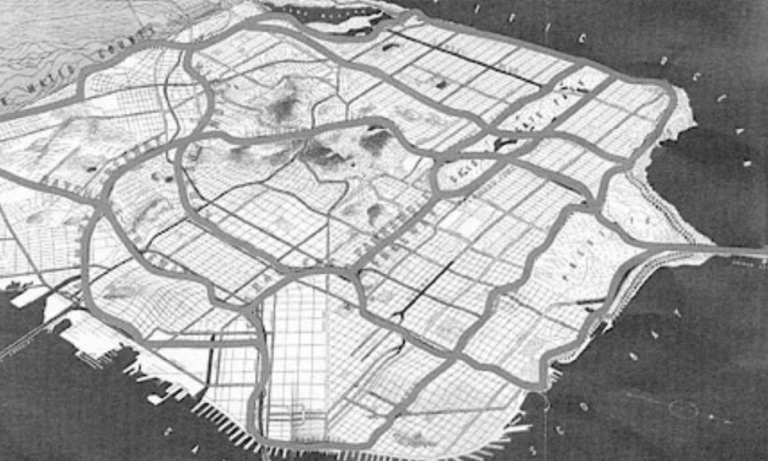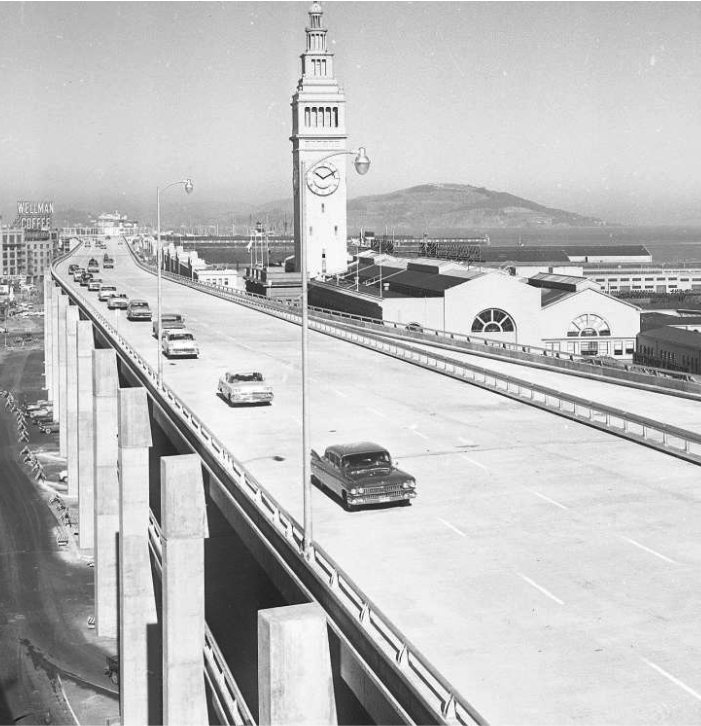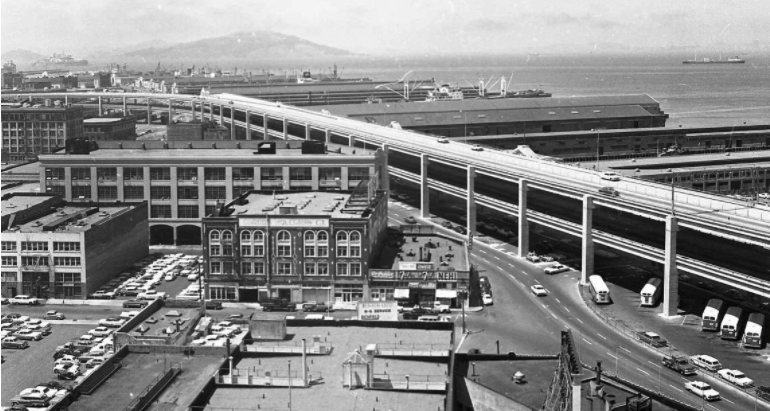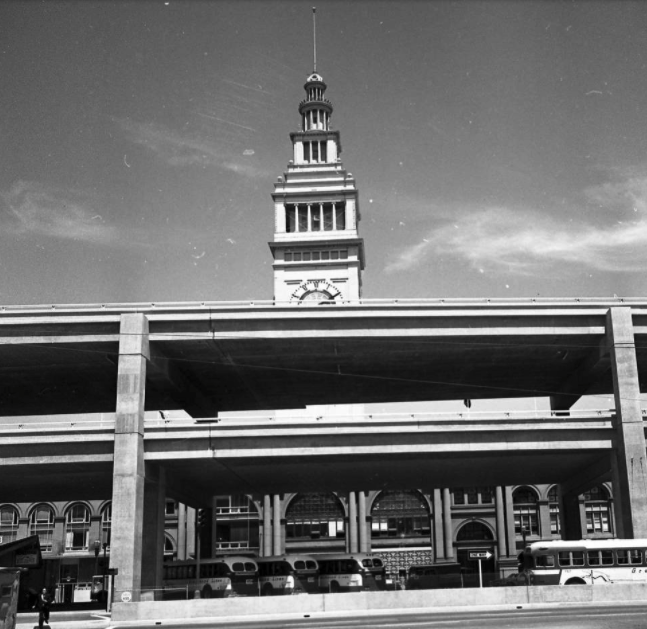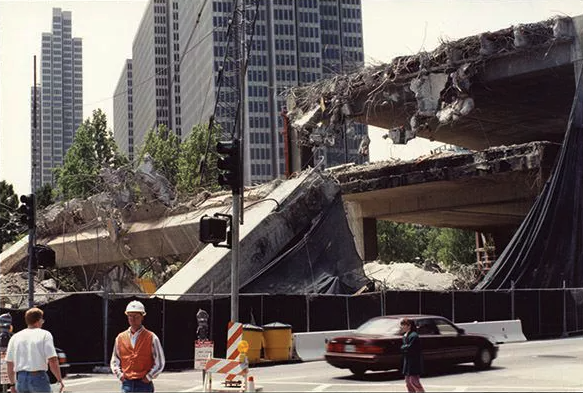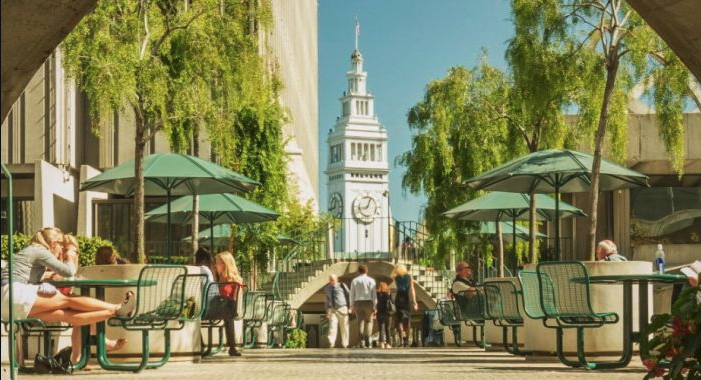Study Guide: The Embarcadero Freeway
Birth of the Concrete Jungles
Building on the economic gains of WW II, the USA became a concrete-spewing monster, and California led the way in freeway construction.
San Francisco is a small city of densely packed buildings and hills on the edge of one of the planet’s most active and dangerous fault zones. This is not an ideal location for sprawling highways, but that did not stop corrupt public employees and well-connected construction company managers from seeking to cash in on the national spending binge.
They created the San Francisco “Comprehensive Transportation Plan” with the goal of ringing every section of the city with massive freeways. One rather reasonable goal was to reduce congestion on the crowded city streets by connecting the Golden Gate and San Francisco Bay Bridges.
Even The Chronicle, a local paper that usually editorialized solidly on the side of large businesses, fought the rising tide of foolish development by describing the Embarcadero Freeway as a “hideous monstrosity” and “such an evil.”
Ignoring the public outrage, the first section of what became California State Route 480 was opened in 1959. Drivers could now swoop off the Bay Bridge into North Beach or Chinatown in a matter of minutes, much to the pleasure of local merchants.
Once finished, the Embarcadero Freeway separated San Francisco’s Downtown District from the bay, and left the iconic Ferry Building–a survivor of the 1906 earthquake—stranded behind an ugly wall of concrete, vehicle exhaust and traffic noise.
Koyaanisqatsi: Life Out of Balance
In the Hopi language, the word Koyaanisqatsi means “life out of balance”.
The closing scenes of the great 1982 experimental film Koyaanisqatsi, by Godfrey Reggio, Philip Glass and Ron Fricke features a fast-paced ride through San Francisco on top of the concrete snake.
This film is a visual tone poem containing neither dialogue nor narration. It simply combines images and music. Reggio explained the lack of dialogue by stating, “it’s not for lack of love of the language that these films have no words. It’s because, from my point of view, our language is in a state of vast humiliation. It no longer describes the world in which we live.”
In 2000, the film was selected for preservation in the United States National Film Registry by the Library of Congress for being “culturally, aesthetically, or historically significant”. Watch the closing scene here:
Birth of the Environmental Movement
Freeway plans for San Francisco didn’t stop at the Embarcadero. A tunnel and freeway down the middle of the Golden Gate Park’s Panhandle section was also planned. Widespread opposition across the city grew. On May 17, 1964, it came to a dramatic climax when 200,000 people gathered in Golden Gate Park to demonstrate their opposition to any more freeways.
During the gathering, folk singer Malvina Reynolds sang her new anti-freeway song “Cement Octopus”.
There's a cement octopus sits in Sacramento, I think.
Gets red tape to eat, gasoline taxes to drink,
...
That octopus grows like a science-fiction blight,
The Bay and the Ferry Building are out of sight.
Cement Octopus, by Malvina Reynolds
In ever larger numbers, North Americans rallied around an emerging environmental movement. “The Freeway Revolt” pitted environmentalists, scientists, and extraordinary citizens against the entrenched power of ordinary public servants and the profit-maximizing corporations that they too often served.
The protests worked, and in 1966 plans for the Crosstown Tunnel, the Golden Gate Freeway and the Panhandle Freeway were all cancelled. But the Embarcadero Freeways was already built, and continued to haunt the San Francisco skyline.
The Power of Money
Following decades of strife, a proposal to tear the freeway down was proposed in 1986. Due to the influence Chinatown representative Rose Pak, who saw the freeway as integral to the economic success of her district, and the support of Broadway Street strip joint owners who also benefitted from increased business, the proposal was voted down.
Nature to the Rescue
In the end it was an act of nature, not reason or politics, that closed the freeway. On Oct. 17, 1989, the Loma Prieta Earthquake shook the city, causing severe damage to the freeway. The freeway ramps were shut for safety, and Caltrans explored plans to retrofit the structure against future earthquakes.
When it became clear that fixing the poorly constructed freeway would cost as much as rebuilding it from scratch, Mayor Art Agnos argued that the city would squander “the opportunity of a lifetime” if it allowed the ugly freeway to remain. After many heated debates, the Board of Supervisors narrowly voted in favor of demolition by a 6-5 margin.
The wrecking balls began swinging on Feb. 27, 1991. While all who loved San Francisco were thrilled at the removal of the blighted structure, Agnos suffered political consequences. He was defeated for re-election when Pak refused to support him. For many years after the Embarcadero area continued to suffer from the scarred remains of the freeway.
The Opportunity of a Lifetime"
While Pac and the developers are mere footnotes in a larger story, Mayor Agnos is remembered for standing tall in the face of entrenched powers by working to restore some of the former glory of a once beautiful city.
Today the Embarcadero is vastly improved. It has become a beautiful destination for shoppers and tourists, joggers and bicyclists, street artists and sightseers, global wanderers and the home free, as well as dock workers, boat builders and fisher folk.
The Best Is Yet To Come…
G B7
Sittin' in the mornin' sun
C A
I'll be sittin' when the evenin' come
G B7
Watching the ships roll in
C A
Then I'll watch 'em roll away again, yeah
[Chorus]
G E
I'm sittin' on the dock of the bay
G E
Watching the tide roll away
G A
Ooo, I'm just sittin' on the dock of the bay
G E
Wastin' time
[Verse 2]
G B7
I left my home in Georgia
C A
Headed for the 'Frisco Bay
G B7
I have nothing to live for
C A
Look like nothin's gonna come my way
[Chorus]
G E
So I'm just gonna sit on the dock of the bay
G E
Watching the tide roll away
G A
Ooo, I'm sittin' on the dock of the bay
G E
Wastin' time
[Bridge]
G D C G
Look like, nothing's gonna change
G D C G
Everything still remains the same
G D C G
I can't do what ten people tell me to do
F D
So I guess I'll remain the same, yes
[Verse 3]
G B7
Sittin' here resting my bones
C A
And this loneliness won't leave me alone
G B7
It's two thousand miles I roam
C A
Just to make this dock my home
[Chorus]
G E
Now I'm just gonna sit at the dock of the bay
G E
Watching the tide roll away
G A
Ooo, I'm sittin' on the dock of the bay
G E
Wastin' time



